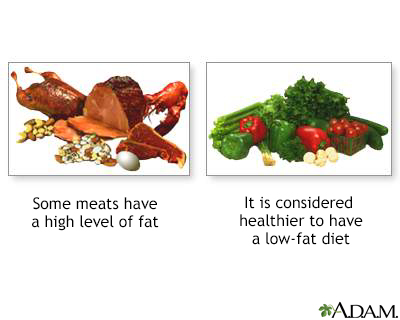Pregnancy SmartSiteTM
Obesity - grocery shopping; Overweight - grocery shopping; Weight loss - grocery shopping; Healthy diet - grocery shopping DescriptionA key step for losing weight, keeping the weight off, and staying healthy is learning how to buy the right foods at the store. This will ensure you have healthy choices at home. Avoid regularly bringing chips or cookies into the home. Instead, having to go out to buy an unhealthy treat gives you more time to make a conscious decision about eating that food. It is fine to include these foods in your diet, but you don't want to eat them mindlessly. Smart ShoppingIf you buy large amounts or bulk packages of a snack food, divide it into smaller portion sizes and store what you will not use right away. PROTEIN When you buy protein, choose:
FRUITS AND VEGETABLES Buy plenty of fruits and vegetables. They will fill you up and provide vitamins, minerals, and other nutrients your body needs. Some buying tips:
Frozen fruits and vegetables can be good choices as long as there is no added sugar or salt. Some benefits of frozen fruits and vegetables include:
BREADS AND GRAINS Choose healthy breads, cereals, and pasta, such as:
Limit refined grain or "white flour" products. They are much more likely to:
Plan AheadBefore you buy food for the week, think about your schedule:
Then, plan your meals before you shop. This ensures that you have what you need to make healthy choices throughout the week. Make a shopping list. Having a list reduces impulse buys and ensures that you will purchase all of the ingredients you need. Try not to go food shopping when you are hungry. You will make better choices if you shop after you have had a healthy meal or snack. Think about shopping along the outer aisles of the store. This is where you will find produce (fresh and frozen), meats, and dairy. The inner aisles generally have less nutritious foods. Know How to Read Food LabelsLearn how to read the Nutrition Facts labels on food packages. Know what the serving size is and the amount of calories, fat, protein, and carbohydrates per serving. If a bag contains 2 servings and you eat the whole bag, you will need to multiply the amount of calories, fat, protein, and carbohydrate by 2. People with special health needs will need to pay extra attention to certain parts of the label. For example, if you have diabetes, you should note the grams of carbohydrates in the food. People on a heart healthy diet will need to pay attention to the amount of sodium and saturated fat. Nutrition labels also now include the amount of added sugars. Use this knowledge to make healthy choices. Two words on food labels that can be misleading are "natural" and "pure." There is no uniform standard for using these words to describe foods. Some other tips for reading labels and buying healthy foods are:
ReferencesGonzalez-Campoy JM, St. Jeor ST, Castorino K, et al. Clinical practice guidelines for healthy eating for the prevention and treatment of metabolic and endocrine diseases in adults: cosponsored by the American Association of Clinical Endocrinologists/the American College of Endocrinology and the Obesity Society. Endocr Pract. 2013;19(Suppl 3):1-82. PMID: 24129260 pubmed.ncbi.nlm.nih.gov/24129260/. Hensrud DD. Diet and nutrition. In: Goldman L, Cooney KA, eds. Goldman-Cecil Medicine. 27th ed. Philadelphia, PA: Elsevier; 2024:chap 13. US Department of Agriculture and US Department of Health and Human Services. Dietary Guidelines for Americans, 2020-2025. 9th ed. www.dietaryguidelines.gov/sites/default/files/2020-12/Dietary_Guidelines_for_Americans_2020-2025.pdf. Updated December 2020. Accessed September 23, 2024. United States Food and Drug Administration (FDA). Food labeling & nutrition. www.fda.gov/food/food-labeling-nutrition. Updated March 14, 2024. Accessed August 7, 2024. | ||
| ||
Review Date: 7/24/2024 Reviewed By: Stefania Manetti, RD/N, CDCES, RYT200, My Vita Sana LLC - Nourish and heal through food, San Jose, CA. Review provided by VeriMed Healthcare Network. Also reviewed by David C. Dugdale, MD, Medical Director, Brenda Conaway, Editorial Director, and the A.D.A.M. Editorial team. View References The information provided herein should not be used during any medical emergency or for the diagnosis or treatment of any medical condition. A licensed medical professional should be consulted for diagnosis and treatment of any and all medical conditions. Links to other sites are provided for information only -- they do not constitute endorsements of those other sites. No warranty of any kind, either expressed or implied, is made as to the accuracy, reliability, timeliness, or correctness of any translations made by a third-party service of the information provided herein into any other language. © 1997- A.D.A.M., a business unit of Ebix, Inc. Any duplication or distribution of the information contained herein is strictly prohibited. | ||


 Food label guide f...
Food label guide f... Healthy diet
Healthy diet
